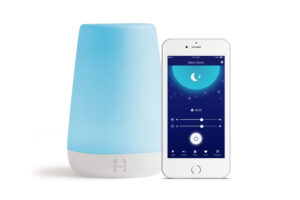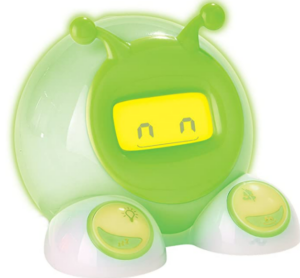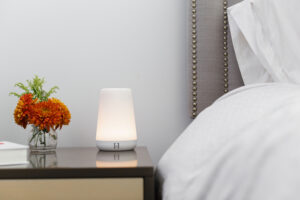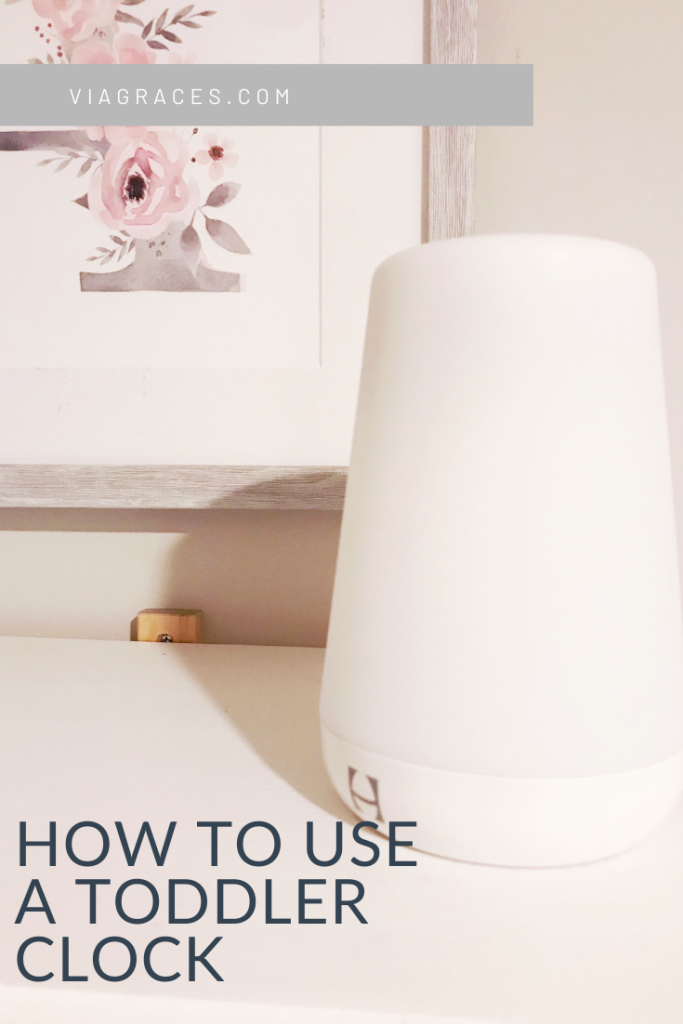Whether you call them the “Terrible Twos and Threes” or “Terrific Twos and Threes,” we all know that toddler life is crazy – good crazy and messy crazy.
With this newfound independence and language often comes some sort of sleep regression or change in sleep patterns, and one great tool to introduce at this time to help lean into both boundaries and also that independence your child craves so much is a toddler clock!
Even if your toddler is not struggling with sleep, it’s still a great tool to introduce/implement!
In this post I’ll share:
- What a toddler clock is
- The best toddler clocks
- How toddler clocks can help your child sleep better
- What age you can start using a toddler clock
- How to introduce a toddler clock to your child
And more!
What is a toddler clock?
When I say “toddler clock,” I’m talking about some sort of visual device that makes it easy for your little one to understand when it’s nighttime and when it’s morning time – when they’re supposed to be in bed and sleeping, and when it’s time to get up for the day!
Toddler clocks are usually based on a colored-light system, but they’re all a bit different!
The most popular toddler clocks include the Hatch Rest, the OK to Wake Clock, and the LittleHippo Mella clock.
The Best Toddler Clocks
If your little one has a birthday coming up, or you’re putting together a holiday wishlist, consider adding one of these toddler clocks to the list!
Hatch Rest
Our family favorite and what we recommend to the families we work with is the Hatch Rest. It’s a little egg-shaped light that can sit on a shelf. And the main reason we love it is because you can control it right from your phone!

You can manually turn the light on in the morning, or you can set a program for what time the light comes on in the morning and your child can even choose which color they want to wake up to – green, blue, purple, etc.
And then if, for whatever reason, you need to change what time the color comes on but your child is already asleep, you can simply change it right from your phone! You don’t have to worry about sneaking into their room to do so.
If your little one is afraid of the dark, you can also set it to red and use it as a night light overnight, and then have the color change at wake-up time.
Read this blog post to learn more about why the Hatch Rest is our favorite toddler clock, as well as the different ways you can use it.
OK to Wake Clock
Another classic toddler clock is the Ok to Wake Clock. It;s one of the original toddler clocks, and it kind of looks like a cute little green alien alarm clock.

The clock lights up green when it’s time for your little one to get up for the day, and it also has a night light function that you can keep on or turn off.
The reason I don’t love the Ok to Wake Clock is that it works like a standard alarm clock, where you have to manually set it from the clock. So if your little one is already sleeping, it’s going to be tougher to change. And it’s harder to implement at the beginning because you can’t be as flexible with the morning wake time.
But I know people who love it and it absolutely works!
LittleHippo Mella
The other popular toddler clock is the Little Hippo Mella. I’ve not personally used it, but I’ve heard great things!

It seems like a fancier Ok to Wake clock. You still have to set it manually, but there are more color options for your toddler to choose to wake up to. And it has a cute little face on the screen that looks like it’s sleeping when it’s sleep time, which is fun.
Digital Clock
I’ve even known people who have used a classic digital clock, but they cover up the minutes and talk about waiting for the “magic 7”. So rather than waking up when the light turns green, they know they can get out of bed when they see the “magic 7”.
How Toddler Clocks Can Help Your Child Sleep Better
First, know that we will never say, “You have to get this one product. If you don’t, sleep just won’t happen.” We will give our favorite product recommendations, but we will not say, “You must get a toddler clock, or else your child will never sleep.”
We do, however, think toddler clocks are really helpful and can make your toddler’s sleep go from, “It’s find, just unpredictable,” to, “Good! I love that I have a good idea of what to expect day to day!”
Morning Time
The biggest “why” behind toddler clocks is morning time. Whether your little one is an early riser or not, toddler clocks are really helpful in letting your child know the difference between nighttime and morning time.
Their room is hopefully nice and dark, so there shouldn’t be outside light streaming in to wake them up for the day. So if they stir at night or in the morning, your toddler can take a peek at their light – if it’s still red, “red means bed,” or if it’s still off, it’s still sleep time! But if it’s blue, or green, or purple, mom and dad are about to get me out of my crib, or now I can get out of my bed.
Toddler clocks are especially helpful for the little ones who do tend to be early risers! Very few people want to start their day before 6:00 am, but if you do, you probably want to start your day solo.
So rather than your toddler jumping in their crib from 5:30-6 am until you get them up, or rather than telling your five-year-old, “Go back to your room, it’s still nighttime” four times, your child learns to rely on the clock.
Teaching them they have to remain in bed, lying down, and quiet until their light comes on can actually re-train them to fall back asleep and re-set their little body clocks to a more reasonable time! Maybe the kiddo who once woke up every day at 5:30 am now wakes around 6 or 6:30, because we were able to re-train their body clocks using the toddler clock!
[We share in-depth about how to solve these early wakings in our guide about How to Solve Early Morning Wakings, so make sure you check it out!]
Finally, depending on your child’s age and “house rules,” you get to decide what happens when the light comes on – do you go get them? Can they come out of their room? Is that when they can get up but stay in their room reading or playing until a certain time?
Night Light
Some parents also use their toddler clock as a night light. A rule of thumb we have around night lights, however, is to only introduce one if your child has expressed a fear of the dark, which usually doesn’t come up until kids are closer to three.
So if their sleep is all of a sudden thrown off – maybe they’re protesting bedtime – we aren’t going to say, “Are you afraid of the dark?” Because now we’ve just planted the idea that dark can be scary!
But if your child has expressed a fear of the dark, you can absolutely use a night light. Just make sure to use a red or even orange light, as those colors will not interfere with your child’s sleep like a white or blue light will.
Independence and Consistency
The other reason I love toddler clocks is because of the independence and consistency they bring! It’s so important that we, as parents, remain consistent regarding boundaries and expectations with our children. “What will happen when I…”, is important across the board!
And thinking of sleep…what will happen if I get out of bed at 5:30 am? Do I get to crawl into bed with Mom and Dad? Do I get to go downstairs and watch TV? Do they send me back to my room to sleep? How will I know when I can get out of bed?
And along with consistency from us, as parents, comes independence for our children. While we tell them when it’s bedtime, they can choose their jammies and their books. While we kiss them goodnight, we teach them how to tuck themselves back in if their covers fall off in the middle of the night.
And toddler clocks play a big role in fostering further independence with our kids. Rather than our kids having to go back to sleep “because we said so,” they understand it’s time for sleep because the clock says so.
And rather than having it seem like we’re simply “deciding” when our child can get up for the day, the clock changing colors is “deciding” for us. It teaches the child to look at the clock rather than simply waiting until mom or dad says it’s time.
When to Start Using a Toddler Clock
When we work with families who have kids in an open bed (which is ideally age 3 or older!), we highly recommend a toddler clock, as it helps keep boundaries around the new freedoms an open bed brings.
However, we suggest parents start using a toddler clock sooner, if possible, while their child is still in a crib!
I have found that around the age of two is when kids are able to start understanding the concept of a toddler clock. This is actually when we introduced our oldest to the Hatch and it worked really well! And with my middle daughter, because she was already sharing a room with her big sister, we didn’t really have to teach her to use the Hatch – she just kind of always knew what to do because she saw her sister do it.

This is why some families start using one closer to 18 months, and I think that’s great! They start using it with the idea that, although their child might not yet understand that the light turning on means it’s time to wake up, as soon as they do understand, it’s a routine that’s already in place.
But starting the concept while your toddler is still in a crib is so helpful, because it often helps make the transition from crib to bed that much more seamless. Yes, they have this new freedom, but they also they know the day doesn’t start until the light turns green. So the idea of getting out of bed before it’s green is a lot more foreign, and you have a much better chance of smoother mornings (and maybe even overnights!) if the toddler clock is already a routine.
How to Introduce Your Child to a Toddler Clock
For toddlers still in a crib…
For toddlers who are still sleeping in a crib, the goal is to direct their little eyes and attention to the clock as soon as you go into their room to get them up in the morning.
If you can’t set the clock from your phone, set it for what time they usually wake up, or even err on the side of a bit early so you know it’ll be on when they wake up.
Or if it’s the Hatch Rest, you don’t even have to set it. When you hear your little one wake up, right before you walk in, turn their toddler clock light on, then go in and make a big deal. “Good morning! Wow, the light is green and ‘green means go! I’m so happy to see you, the green light is on so it’s time to wake up!”
Every morning, you’ll turn the light on right before you go in, and then direct their attention to the toddler clock
Then as they start catching on, put some more wait time in there. Now when they wake up, wait 5 minutes before getting them. Then make the light turn green, go in there, and direct their attention to it. The goal is to help them connect the light changing with getting up!
So the end goal is that if your little one wakes up and the light isn’t green, they’ll either go back to sleep or just hang out for 5, 10, or 15 minutes until the light turns green! .
So once you feel good about your child’s understanding of the toddler clock, you can now program it and kind of pick the happy medium of when they usually get up. If they usually wake up between 6:30-7, maybe set the clock for 6:45. Or if they’re content to hang there, you could set it for 7! And know that you’ll get warm coffee in peace until 7 am.
For toddlers and young kids in a big bed…
For toddlers and young kids who are already in an open bed, it will take some more time, practice, and consistency, because they physically can get out of bed sooner. So we have to teach them not to!
When first introducing the toddler clock, explore it during the day and play pretend with it! Make a little game where your toddler lays down and pretends to sleep when their light is off, and then when it turns green, make a big deal about it being time to wake up and let them jump up!
Then switch! You pretend to sleep. Peak your eyes open and say, “Ooo, it’s not on yet, or it’s still red, time for bed!,” and close your eyes again. Then open them again, now it’s green, “Yay!” Show them how exciting it is when the clock changes colors.
This is another reason we recommend the Hatch, because you can change it right there from your phone. Your child can even push the button to make the color change, which is pretty cool!
Then when your child goes to sleep that night, show them where the light is and remind them that the special light will come on when it’s time to wake up. You’ll also want to talk about the new toddler clock quite a bit the first several days you’re implementing it, both during the day and at bedtime.
And if your child is still waking in the night, when you go to respond, direct their attention to the clock. You can say something like, “Your light is still red, and red means bed. It’s time to sleep. Show me how you lay down, close your eyes, and be quiet.”
Although the end goal is to program the clock so that it comes on at the same time each morning (whether your child has been awake for a few minutes or is still asleep), I suggest parents start by setting the bar a bit lower so their child can achieve success more quickly.
For example, if your end goal is for your child to get out of bed at 7:00 am, but right now 6:00 am is the norm, start by setting the toddler clock for 6:10 so you push them a bit but are not expecting something unrealistic, and then keep climbing from there.
We want them to have quick success so they’re excited about it!
This might sound overwhelming, or you might be so ready to get the toddler clock party started! Either way, I want to make sure you have our bedtime routine chart and boundary cards freebie. The printable boundary cards are literally, “Lay down, close your eyes, and stay in bed until___”, and that’s referring to the toddler clock! These cards will help your little one know what to expect, they will help you know what you’re expecting, and the guide gives some more ideas as to how you can use those cards.
Could the toddler clock wake up my child?
Will the toddler clock wake up your child when it comes on in the morning?
I can’t answer that for every child, but I can speak from experience as a mom of two girls who use one every night and morning, and as a sleep consultant who has worked with countless families who use one as well…
The light waking your little one up is uncommon! Has it woken my girls up before? Yes, for sure. At least they’ve said it has. But they were probably in a super light sleep, about to wake up anyway, so I don’t mind! Have they slept through the light changing? Yes, so many times! I’d say at least once a week, if not more. And do they sometimes wake up before it? Yep, probably the majority of the time, and they stay in bed quietly until it changes.
So don’t let the fear of the toddler clock waking your little one keep you from implementing it! The benefits far outweigh the risk of it waking your little one. Plus, if that becomes a pattern, just program the toddler clock to come on later!
Conclusion
If you have a toddler or older child, we highly recommend you consider implementing the use of a toddler clock. It is a great tool to help you, as parents, establish and keep boundaries and expectations around sleep.
It is also helpful for your child to feel more autonomy when it comes to sleep, which is good for us all.
Remember that introducing a toddler clock to your little one will take time; they very likely won’t catch on right away! Some mornings will be easier than others, and that’s to be expected. Stay the course, practice practice practice, and you’ll get there.
And if your little one is still struggling with early morning wakings, waking up all night long, or they won’t even stay in bed at bedtime, let alone morning time? We are here for you to make sleep happen!! Check out how we can help.
With Grace,
Lauren
Note that this blog contains some affiliate links, but the reviews are from my personal use.
